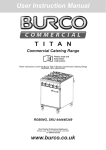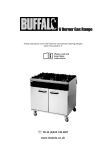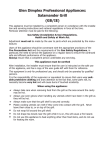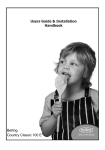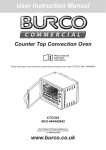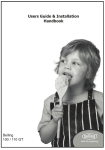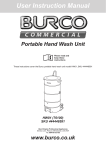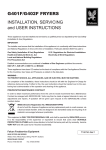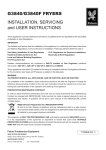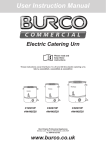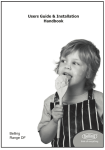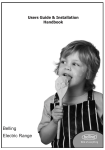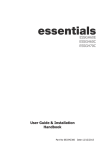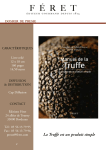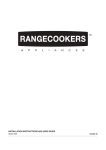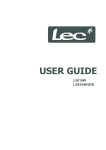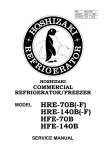Download User Instruction Manual
Transcript
User Instruction Manual T I T A N Commercial Catering Range These instructions cover the Burco Titan Dual Fuel 6 Burner Commercial Catering Range RG90DF/NG, RG90DF/LP, SKU’s 444440350, 444440414 RG90DF/NG, RG90DF/LP SKU’s 444440350, 444440414 Glen Dimplex Professional Appliances Stoney Lane, Prescot, Merseyside, L35 2XW Tel: 0844 815 3755 www.burco.co.uk INTRODUCTION This appliance must be installed by a competent person in compliance with the installation and servicing instructions and national regulations in force at the time. Particular attention must be paid to the following: Gas Safety (Installation & Use) Regulations. Health and Safety at Work etc Act. Adjustment must not be made by the user to parts which are protected by the manufacturer. Users of this appliance should be conversant with the appropriate provisions of the Regulatory Reform Order (Fire Safety) and the requirements of the Gas Safety Regulations, in particular, the need to service the appliance on a regular basis to ensure the continued safe and efficient performance of the appliance. Always ensure that a competent person undertakes any servicing. This appliance must be earthed. After installation, the installer must ensure that the user is instructed on the safe use of this appliance, and has a copy of the user guide left with them for reference. This equipment is only for professional use, and should only be operated by qualified persons. It is the responsibility of the supervisor or equivalent to ensure that users wear suitable protective clothing and draw attention to the fact that some parts will, by necessity, become very hot and will cause burns if touched accidently. If the appliance is fitted with castors, please take care to ensure that the front castors are locked when the appliance is in use. Take care when moving the appliance. When using the appliance: 99 Always ensure that pan bases are dry, and flat before using them on the hob. 99 Always position pans over the centre of the burner, and turn the handles to a safe position so they cannot be knocked or grabbed. 99 Always use pans which are the correct size for this appliance (125mm - 420mm). 99 Always take care when removing food from the oven as the area around the cavity may be hot. 99 Always use oven gloves when handling any utensils which have been in the oven as they will be hot. 99 Always make sure that the oven shelves are secured correctly. 88 Never use double pans, rimbased pans, old or misshapen pans, or any pan which is not stable on a flat surface. 88 Never leave cooking fat, or oil, unattended. 88 Never use the hob for any other purpose than cooking food. 88 Plastic cooking utensils can melt if they come into contact with a warm hob. Never leave them close to, or on top of, the hob. 88 Never leave the burner alight without a pan covering it. This causes a fire hazard. 88 Do not place items on the door while it is open. 88 Do not wrap foil around the oven shelves. 88 Do not drape tea towels near the oven while it is on, this will cause a fire hazard. 88 Do not use this appliance to heat anything other than food items, and do not use it for heating the room. WARNING - DOMESTIC TYPE FLEXIBLE RUBBER TUBE CONNECTIONS MUST NOT BE USED WITH THIS APPLIANCE. ONLY TUBE COMPLYING WITH BS669 PART 2. SPECIFICATION FOR CORRUGATED METALLIC FLEXIBLE HOSES FOR CATERING APPLIANCES, SHALL BE USED. WARNING - WHEN APPLIANCES ARE STORED FOR LONG PERIODS PRIOR TO INSTALLATION, ESPECIALLY IN DAMP CONDITIONS, THE INSULATION RESISTANCE OF THE ELEMENTS MAY FALL TO AN UNACCEPTABLE LEVEL. (I.E. BELOW 2 MEGOHM). SHOULD THIS OCCUR, IT IS RECOMMENDED THAT THE ELEMENTS BE SWITCHED ON FOR AN HOUR, THEN ALLOWED TO COOL. THIS PROCESS BEING REPEATED AS NECESSARY TO RESTORE THE REQUIRED INSULATION RESISTANCE. Installation Clearances • No shelf, overhang, cupboard, or cooker hood should be less than 1200mm above the pan supports, but please check this with the hood manufacturers instructions. • The appliance must have a clearance of 100mm from any combustible material (wooden cabinets etc). At the rear, the appliance can be pushed back until the gas rail support bracket touches the wall. These appliances must be installed and serviced by a competent person as stipulated by the Gas Safety (Installation & Use) Regulations. IMPORTANT The installer must ensure that the installation of the appliance is in conformity with these instructions and National Regulations in force at the time of installation. Particular attention MUST be paid to: • Gas Safety (Installation & Use) Regulations • Health And Safety At Work etc Act • Local and National Building Regulations • Regulatory Reform Order (Fire Safety) • Detailed recommendations are contained in Institute of Gas Engineers published documents: IGE/UP/1, IGE/UP/2 • BS 6173 and BS 5440-2 • In IE, IS 820 Non-domestic Gas Installations These appliances have been CE-marked on the basis of compliance with the Gas Appliance Directive for the Countries, Gas Types and Pressures as stated on the Data Plate. Pay particular attention in order not to disturb the air combustion admission or the combustion products evacuation of the appliance. WARNING - TO PREVENT SHOCKS ALL APPLIANCES, WHETHER GAS OR ELECTRIC, MUST BE EARTHED. On completion of the installation, these instructions should be left with the Engineer-inCharge for reference during servicing. After installation / service these Instructions should be handed over to the User, having had a demonstration of the operation and cleaning of the Appliance. INSTALLATION AND SERVICE GUIDE IT IS MOST IMPORTANT THAT THESE INSTRUCTIONS BE CONSULTED BEFORE INSTALLING AND COMMISSIONING THIS APPLIANCE. FAILURE TO COMPLY WITH THE SPECIFIED PROCEDURES MAY RESULT IN DAMAGE OR THE NEED FOR A SERVICE CALL. PREVENTATIVE MAINTENANCE CONTRACT In order to obtain maximum performance from this unit we would recommend that a Maintenance Contract be arranged. Visits may then be made at agreed intervals to carry out adjustments and repairs. WEEE directive registration no. WEEE/DK0059TT At end of unit life, dispose of appliance and any replacement parts in a safe manner, via a licenced waste handler. Units are designed to be dismantled easily and recycling of all material is encouraged whenever practicable. SECTION 1 - INSTALLATION AND SERVICE GUIDE UNLESS OTHERWISE STATED, PARTS WHICH HAVE BEEN PROTECTED BY THE MANUFACTURER ARE NOT TO BE ADJUSTED BY THE INSTALLER. 1.1 SITING The appliance should be installed on a level, fireproof surface, in a well lit and draught free position. Should the floor be of combustible material, then local fire requirements should be checked to ensure compliance. There should be a minimum vertical clearance of 1200mm above the top of the pan supports. Important If the appliance is to be installed in suite formation with other matching appliances, the instructions for all models must be consulted to determine the necessary clearances to any combustible rear wall or overlying surface. Some appliances require greater clearances than others, and the largest figure quoted in the individual instructions will therefore determine the clearance of the complete suite adjoining appliances. The oven discharges vertically through the vent at the hob rear. There must be no direct connection of the flue to any mechanical extraction system or the outside air. Hotplate burners discharge combustion products directly into the room. Siting the appliance under a canopy is the ideal arrangement. 1.2 VENTILATION Adequate ventilation, whether natural or mechanical, must be provided to supply sufficient fresh air for combustion and allow easy removal of combustion products which may be harmful to health. Recommendations for Ventilation of Catering Appliances are given in BS5440-2. For multiple installations the requirements for individual appliances should be added together. Installation should be made in accordance with local and/or national regulations applying at the time. A competent installer MUST be employed. 1.3 GAS SUPPLY The incoming service must be of sufficient size to supply full rate without excessive pressure drop. A gas meter is connected to the service pipe by the Gas Supplier. Any existing meter should be checked by the Gas Supplier to ensure that the meter is of adequate capacity to pass the required rate of the appliance in addition to any other gas equipment installed. Installation pipe work should be fitted in accordance with IGE/UP/2. The pipe work should be of adequate size but not smaller than the gas inlet connection on the appliance, i.e. Rp 3/4 (3/4” BSPP female). An isolating cock must be located close to the appliance to allow shut-down during an emergency or servicing of the gas supply. Tubing shall comply with the national requirements in force and shall be periodically examined and replaced as necessary. The installation must be tested for gas tightness. Details of this procedure can be found in IGE/UP/1. 1.4 ELECTRICAL SUPPLY This appliance is suitable for AC supplies only. The standard unit terminal arrangement is for use on a two phase supply (with neutral), terminal block 1. By adding the links, positioned between L1, L2 and L3 on terminal block 2, the range can be converted for single phase. Refer to wiring diagram for further information. The electrical ratings are 230V, 4.8kW 400V 2N˜ (4.8kW) L1 = 2.4 kW/ L2 = 2.4kW 1.5 HEAT INPUTS - ELECTRICAL / NATURAL AND PROPANE GAS Gas Heat Input (kW net) Country Gas GB/IE Natural gas (G20) GB/IE Propane (G31) Hotplate 6.1 kW 5.4 kW Total 36.6 kW 32.4 kW Gas Heat Input, Low Setting (kW net) Hotplate 1.0 kW 1.0 kW Electrical Input, (kW) Oven 4.8 kW 4.8 kW 1.6 INJECTOR & BYPASS STAMPINGS - NATURAL AND PROPANE GAS Injector Stamping Bypass Screw Stamping Country Gas Hotplate Hotplate GB/IE Natural gas (G20) 193 48 adj. out GB/IE Propane (G31) 120 48 screwed in 1.7 GAS PRESSURE ADJUSTMENT - NATURAL AND PROPANE GAS Country Gas Gas Pressure GB/IE Natural gas (G20) 20 mbar GB/IE Propane (G31) 37 mbar Pressure test point is located towards the centre of gas manifold situated behind front control facia. Connect a manometer and check that supply pressure is correct when the oven burner is ignited and then turned to the highest temperature setting. 1.8 BURNER ADJUSTMENT - NATURAL AND PROPANE GAS Hotplate and oven burners are fitted with fixed bypass screws and set aeration apertures, NO ADJUSTMENT is possible. SECTION 2 - ASSEMBLY AND COMMISSIONING 2.1 ASSEMBLY Assembly of Ranges Note: The following paragraphs should be read as applicable to the unit being assembled. 1. If the appliance is supplied with feet: Unpack appliance and place unit in position using the feet adjusters to level appliance. 2. Open oven door, pull out shelves and loose base panel. Check burner spark igniter arrangement is correctly located and secured. Ensure ALL packing etc. is removed from oven. Replace all parts in reverse sequence. 3. Check hotplate, remove packing, etc. from hob area and ensure that all burners and pan supports are secured in position. The hotplate burner caps fit loosely upon aluminium skirts of lift-off construction. 2.2 CONNECTION TO GAS SUPPLY Connect appliance to gas supply. Test for gas tightness. The integral gas supply downstream of gas valve may be checked by applying leak detection spray with burner lit. Appliance inlet connection terminates at upper rear RH side in Rp 3/4 (3/4” BSPP female). 2.3 CONNECTION TO ELECTRICAL SUPPLY The cable entry is located at the bottom rear of the unit and must be connected using a 20mm conduit. A removable plate is provided at the outer back panel to allow access to terminal block. A suitably rated isolating switch with contact separation of at least 3mm on all poles must be fitted to the installation. Wiring should be executed in accordance with current electrical regulations. WARNING - This appliance must be earthed. An earth terminal is provided on Terminal Block 1. 2.4 COMMISSIONING THE APPLIANCE Important: Prior to operation, ensure ALL packing material has been removed. 2.4.1 Setting the gas pressure 1. It is necessary to check the gas pressure during commissioning and a suitable pressure gauge must be connected to pressure test point towards the centre of the gas rail behind the facia. 2. Now turn on main gas valve at supply to unit. 3. Turn on 4 hotplate control knobs to their maximum positions. Push and hold and ensure supply pressure is correct. 4. Disconnect pressure gauge from test point. Replace test point sealing screw and test for gas tightness. 2.4.2 Checking the performance of the controls 1. Light each hotplate as detailed in Section 2.4.3. Check ignition is smooth and without delay. Repeat operation several times. 2. Place a thermometer in centre of oven and select 225°C on thermostat knob. Allow oven to heat up and check temperature is 225 +/- 15°C. If temperature reading is outside specified range, there may be a faulty thermostat, in which case the unit should be serviced (see thermostat replacement and calibration procedure). Turn OFF electrical supply and allow a sufficient cool down period before removing thermostat. 2.4.3 Lighting sequence Important: Prior to operation, ensure ALL packing material has been removed from appliance. Hotplate 1. Ensure mains gas is turned on. 2. To light hotplate burners, press knob and turn to full flame position. Ignite burners using taper or match. Hold in knob for 5 - 10 seconds and then release. Check burner remains lit and turn knob to required position. 3. To turn the hotplate off, turn knob to OFF position. Oven 1. Switch on electrical supply at mains. Green neon indicator should illuminate. 2. Turn oven thermostat knob clockwise, the fans should rotate clockwise. Amber neon indicator will illuminate when setting is higher than actual oven temperature. 3. Thermostat will cycle on/off in order to maintain set temperature. 4. To turn oven off, turn knob to OFF position. 2.5 INSTRUCTION TO USER Whenever possible, the installer should ensure that the user thoroughly understands the instructions for lighting, cleaning and correct use of the appliance. It is also important to ensure that the location of the gas isolating cock is made known to the user, and that the procedure in an emergency is demonstrated. SECTION 3 - SERVICING IMPORTANT: BEFORE ATTEMPTING ANY SERVICING, ENSURE ISOLATING COCK IS TURNED OFF AND CANNOT BE INADVERTENTLY TURNED ON, AND ISOLATE THE ELECTRICAL SUPPLY. AFTER ANY MAINTENANCE TASK, CHECK APPLIANCE TO ENSURE THAT IT PERFORMS CORRECTLY AND CARRY OUT ANY NECESSARY ADJUSTMENTS AS DETAILED IN SECTION 1. After carrying out any servicing or exchange of gas carrying components ALWAYS CHECK FOR GAS TIGHTNESS! Electrical wiring diagram is included at the back of this handbook. 3.1 REMOVAL OF CONTROL PANELS AND BURNERS Various panels are removed as follows: 3.1.1 Removal of fascia panel 1. First remove all control knobs. 2. Open oven doors and remove the two screws from the underside of the fascia panel. 3. Remove the two screws at each end of the fascia panel. 4. Lastly remove the 3 fixing screws from the front of the fascia panel. 5. Fascia panel can now be removed from the appliance. 3.1.2 Removal of the hotplate 1. Remove all pan supports, burner caps and burner skirts. 2. Using the front left hand and right hand burner apertures lift the front of the hotplate upwards to an angle of approximately 45° and then pull the hotplate forward. 3. The hotplate should now be free from the rear vent and can be removed from the appliance. 3.1.3 Replacement of hotplate burner (jet holder) 1. Remove hotplate as detailed on the previous page. 2. Disconnect the hotplate pipe from the chosen burner by undoing the compression nut at the burner. 3. Remove the two fixing screws holding the hotplate burner in place. 4. The burner can now be removed from the appliance. 5. The new hotplate burner is to be fitted in the reverse order. 3.1.5 Cleaning Burners should be cleaned periodically to maintain maximum performance. Open top burners should be cleaned as detailed in User Instructions. 3.2 INJECTORS 3.2.1 Hotplate 1. Remove burner caps and skirts. 2. Undo and carefully remove injector. 3. Replace in reverse order. 3.3 THERMOCOUPLES AND FLAME FAILURE DEVICE (FFD) 3.3.1 Hotplate flame failure device magnet unit 1. Undo thermocouple at FFD section of gas tap. 2. Undo FFD section cap at rear of gas tap and withdraw magnet unit and replace in reverse order. 3.3.2 Hotplate thermocouple 1. Remove hotplate as detailed in Section 3.1.2. 2. Remove nut securing thermocouple sensor to burner support bracket and pull thermocouple through support bracket from underside. 3. Undo thermocouple connection at FFD section of gas tap and carefully remove thermocouple. 4. Replace in reverse order, take care not to overtighten thermocouple. 3.4 OVEN THERMOSTAT Thermostat calibration: The thermostat does not require calibration. If centre oven temperature is outside specified tolerances then replace thermostat and return faulty thermostat to the Customer Care Centre. 1. Remove control knobs and facia panel as detailed in Section 3.1.1. 2. Remove hotplate as detailed in Section 3.1.2. 3. From inside the oven, note the route/location of the thermostat capillary/phial. 4. Gently pull the thermostat phial free from the left clip. Slide the phial to the left to free the phial’s clenched end from the right clip’s locator hole. 5. Carefully feed capillary and phial through the oven top panel’s hole. 6. Undo fixings which secure thermostat to fascia panel, separate selector switch from thermostat by pulling apart. 7. Replace all parts in reverse order. 3.5 GAS TAPS Note: Plugs and bodies are machined in pairs and are therefore not interchangeable. Always clean one tap at a time. 1. Remove control knobs and facia panel as detailed in Section 3.1.1. 2. Remove hotplate as detailed in Section 3.1.2. 3. Undo thermocouple connection at FFD section of gas tap. Undo burner supply pipe at gas tap rear. 4. Undo fixings which secure tap to gas rail. 5. Replace all parts in reverse order, renewing o-ring seal if necessary. Take care not to overtighten thermocouple connection at gas tap rear. 3.6 NEON INDICATORS 1. Remove control knobs and facia panel as detailed in section 3.1.1. 2. Disconnect wires from indicator. 3. Remove indicator from panel and withdraw. 4. Replace in reverse order. 3.7 OVEN ELEMENTS 1. Remove shelves and back baffle. 2. Undo element fixing screw and withdraw into oven. 3.8 RELAYS 1. Remove cover plate from rear terminal box. 2. Undo electrical connections from relay and remove fixings. 3. Replace in reverse order. Electrical connections to be restored as detailed in wiring diagram. 3.9 CONTROL FUSE The control fuse is located within rear terminal box. 3.10 THERMAL CUTOUT A thermal cutout is fitted to oven chamber back panel. Access is through outer back panel cover plate. To reset, press button in centre of cutout. To remove, undo bracket fixings. Replace in reverse order. WARNING: IF THE THERMAL CUTOUT HAS TRIPPED, THE REASON FOR OVERHEATING MUST BE IDENTIFIED AND REMEDIED BEFORE PUTTING THE UNIT BACK INTO SERVICE. Note: If space is restricted at rear of unit, overheat safety trip may be accessed through the oven compartment by removal of fan support panel. Slacken top and bottom fixings of fan baffle and tilt baffle forward to remove. Undo fan support panel fixings and fold sideways. Take care not to strain electrical wiring. 3.7 FAULT CHECK LIST If a flame is not established on any hotplate burner, follow this check list: 1. 2. 3. 4. 5. Check mains gas is ON. Check pressure at pressure test point to ensure gas is flowing to the appliance. If gas is present then check burner injector for blockage. If injector is clear then check FFD magnet unit is engaging and allowing gas to pass. If a flame is still not present then re-check from start. If a flame is established but not maintained then follow this check list: 1. Check thermocouple sensor is secured correctly and that burner ports are clean. 2. Check that thermocouple is not damaged and is securely fixed to FFD section of gas control. 3. Check FFD is energising and maintaining flame. 4. If after carrying out the above, the burner is still not maintaining the flame then check magnet unit within control. SECTION 4 - SPARES When ordering spare parts, always quote the appliance type and serial number. This information will be found on the data badge attached on the rear of the product. USER’S GUIDE SECTION 1 - ABOUT YOUR APPLIANCE All models are fitted with flame failure devices to shut off gas supply to burners if flames are extinguished. The oven is thermostatically controlled. All taps are the safety type with fixed HIGH and LOW settings. Hotplate controls Control knob markings are as indicated below. Off High Low Oven thermostat The oven is thermostatically controlled. The control knob markings are in degrees celsius. Off 50 100 150 200 250 Temperature increments These controls are identified by the symbols (shown below) which are on the facia. Left hand hot plate burners Heating Centre Right hand hot plate burners hot plate burners On Oven Control Front burner symbol Rear burner symbol SECTION 2 - LIGHTING AND OPERATION Hotplate 1. Press and turn knob to full flame position. 2. Light burner using taper or match and continue to hold knob in for a further 5 - 10 seconds before release. 3. Burner should remain lit but if burner goes out return to Step 1 and repeat ignition procedure. 4. When burner remains lit, turn knob to required position. To turn the hotplate off, turn knob to OFF position. IMPORTANT INFORMATION PLEASE READ THE FOLLOWING VERY CAREFULLY....AVOID MIS-USE! (MIS-USE OF THIS PRODUCT CAN BE HARMFUL). Guidance Rules for the SAFE USE of a gastronome pan on the hotplate, Size 2/1 or 1/1 gastronome pans. • Whenever two or more hotplate burners are operated below a gastronome pan, the heat input of each burner should be reduced. • If only two burners are to be used, we recommend you use one front burner and one rear burner as a pair. • On a six burner hotplate, we recommend you use the two central burners. • With the pan in position, light one burner and turn its control knob anti-clockwise to a position no greater than midway between the large & small flame symbols. • Repeat this procedure for the remaining required burners. • Slowly rotate the control knob of each burner in use, to fine tune the flame sizes to the desired heat inputs. • The aim is to make all burner flame patterns look identical. • This will ensure that the heat is evenly distributed to the pan and its contents. • On no account should any flame be licking up the sides of the pan or elongated in anyway. • If any flames are lengthening, keep viewing the flames whilst turning the relevant burners’ control knob anti-clockwise towards the small flame symbol, until rectified. • If burning propane, ensure there is no excessive yellow tipping which could lead to soot deposits and/or poor combustion. • BE SAFE, WHEN USING A GASTRONOME PAN ON THE HOTPLATE....ALWAYS HEAT THE CONTENTS GENTLY AND EVENLY....TURN FLAMES DOWN. Oven 1. Ensure main supply is on. Green mains ON indicator should illuminate. 2. Turn control knob clockwise to desired setting. Amber HEATING indicator will light and remain lit until temperature is reached. 3. Do not leave doors open for longer than is necessary to load or unload oven. To turn the oven burner off, turn thermostat control knob to ‘O’ position. Warning: The area around the oven will become very hot while the oven is in use. Take care when opening the oven doors. SECTION 3 - COOKING HINTS Hotplate The pan supports will safely accommodate pans from 125mm diameter up to 420mm maximum. Note: For maximum efficiency, place pan centrally over burner head and adjust control setting to avoid flames licking up pan sides. Shelves Two cooking shelves are supplied which can be supported in any of four different positions within the oven. When two shelves are being used, these should be positioned so that at least one single shelf space is left between them. Always push shelves into oven until the stops hit the rear of the supports. Tray sizes A 900mm wide oven will accommodate a 2/1 gastronorm tray. Single trays or dishes should be placed centrally. Trays must not be allowed to overhang the shelf in any direction as this will adversely affect heat circulation. In particular, NEVER block the space beyond the rear shelf upstand. Preheat time Allow at least 15 minutes from lighting a cold oven before a full load of food may be cooked. Put food in quickly and close the doors firmly. SECTION 4 - CLEANING AND MAINTENANCE All surfaces are easier to clean if spillages are removed before they become burnt on and if units are cleaned daily. Stainless steel surfaces These surfaces should be cleaned with hot water and detergent then dried and polished with a soft cloth. Cleaning agents containing bleach, abrasives or caustic chemicals will damage or mark the stainless steel surfaces and must not be used. Vitreous Enamel Surfaces Approved cleaning agents which have the mark of the Vitreous Enamel Association are recommended. It is advisable to clean daily after use. Wipe clean the vitreous enamel surfaces while they are still warm using a soft cloth and hot soapy water. Badly stained, removable parts should be soaked in hot water with an approved detergent. If the parts are not removable from the unit the application of warm water with approved detergent using nylon or scotch cleaning pads will give good results. Hotplate Burner cleaning should be carried out daily. Burner efficiency will be reduced significantly if recommended cleaning is not carried out. 1. Remove pan supports and hotplate burner caps Wash all parts with hot soapy water according to detailed instructions enclosed at end of section. 2. After washing, dry all parts well and ensure all water is removed from inside burner head. 3. The hob may be lifted off for cleaning purposes. Using the front left hand and right hand burner apertures lift the front of the hotplate upwards to an angle of approximately 45° and then pull the hotplate forward. 4. Re-fitting the hotplate: Rest hotplate on the top of the appliance at 45° and slide back until the rear flange is under the vent trim. Then lower the hotplate onto the side panels. 5. Dry off the pan supports by hand. NEVER LEAVE THESE TO DRY NATURALLY. Hotplate Burners The following instructions should be followed when: • A spillage has occurred on the burner. • The burner fails to light or stay alight. • At the end of each day or cooking period. Caution: Parts may be hot therefore protection to avoid burns should be used. 1. Remove pan support. 2. Remove burner cap and skirt by lifting upward. 3. Thoroughly clean with soap and water. Ensure all burner ports are clean and free from food or cleaning material debris. Important: Stubborn debris lodged in ports can be removed using a non metal implement such as a cocktail stick. The base should be cleaned of debris using a soft brush. Dry burner caps with soft cloth and blow through the ports to ensure there is no blockage. 4. Clean any spillage from burner skirts, ensuring all food and cleaning material debris is removed. Dry burner skirts thoroughly, taking care not to damage the flame sensor. Important: Do not allow any spillage or cleaning material debris to enter the large hole in the burner skirts. 5. Replace burner caps and skirts upon burner base and ensure the cap location fits within burner skirt notches. When burner head is properly located, it will not rotate. 6. Light burner to check that it operates correctly. Note: Ensure that all parts are dried thoroughly prior to relighting. Note: This process should be followed prior to calling for a Service Engineer. Failure due to lack of proper cleanings may result in work being charged for. Oven Clean while oven is warm but not hot. The enamelled base plate lifts out. The shelf guides can be removed by removing the four fixings. The oven base is removed by lifting at the front, and pulling towards you. GUARANTEE This appliance is guaranteed against defective materials or faulty workmanship, for a period of 12 months on labour and 36 months on parts. This guarantee is given subject to the appliance being used in accordance with the instructions supplied, and on the supply voltage marked on the rating label. The guarantee is subject to fair wear and tear conditions. The guarantee does not cover consequential damage arising out of any failure acceptable under guarantee, nor does it cover damage resulting from misuse, accident or unauthorised alterations to the appliance. Proof of purchase will be required. In any communication with the supplier or manufacturer, quote the model and serial number marked on the appliance rating label. This guarantee does not affect your statutory rights. The products are intended for commercial use as detailed in these instructions. The Company has a policy of continuous improvement in product quality and design. The Company therefore reserves the right to change the specification at any time. FAQ’s TITAN DUAL FUEL WIRING DIAGRAM Wiring colour code: Bk - Black, Bn - Brown, Bu - Blue, Gn/Y - Green/Yellow, Or - Orange, W - White, Y - Yellow. 691 R TOP TRAY EARTH POINT Y Y Bk POWER INDICATOR 683 GREEN Gn Y Bn 680 HEATING INDICATOR AMBER Bk T’STAT 21 2 1 690 R Or 681 684 Bn 1 P1 SELECTOR Bn Bu A 7 4 1 Or B 9 6 3 680 Y 692 683 687 Bn 2A FUSE Bn 689 689 Or 680 682 THERMAL CUTOUT MANUAL RESET 150C Bu OPERATING RELAY Bk 689 690 Bn Bn Bk 2 P2 681 691 Bu Or W A 7 4 1 B 9 6 3 687 Bu Bk SAFETY RELAY W 688 W 689 693 Bk 683 Bk Bk OVEN ELEMENT Y Y 681 683 680 OVEN STIR FAN 689 685 690 691 L1 R L2 681 OVEN STIR FAN Bk Bu Bk N4 N5 Bu L3 INLET TERMINAL BLOCK 686 OVEN ELEMENT 686 Bk Bn Bn 685 FIT ALL LINKS FOR SINGLE PHASE Y Bk SPARES LIST Part Number 082982600 082982500 532991800 532991900 502991600 503058100 082983500 012980500 082983800 082983802 080125000 082984000 081367387 083056100 082986700 502992900 082980700 082558001 083064900 083064901 082983600 082983601 082233900 081581800 082971300 083055600 082930601 082930602 083055700 082758300 Description Burner cap assembly Burner skirt Oven door outer left hand side Oven door outer right hand side Door oven inner panel Facia panel Handle door Hotplate assembly Control knob (hotplate) Control knob (oven) Locknut thermocouple brass Pan support Screw M3x6 Torx pan head BZP Seal oven Shelf oven Support tap rail rear Thermocouple hotplate Thermostat oven Tap hotplate natural gas Tap hotplate propane Wheel (no brake) Wheel (with brake) Selector switch Oven stir fan Oven element Relay Neon indicator green Neon indicator amber Thermal cutout 150C Handbook Hotplate Type 1 Natural gas, Injector & Holder 082982400 x6 Propane, Injector & Holder 082982401 x6 Qty 6 6 1 1 2 1 2 1 6 1 6 3 1 1 2 1 6 1 1 1 2 2 1 2 2 2 1 1 1 1 Hotplate Type 2 Holder 082982402 x6 Natural gas, Injector 083128101 x6 Propane, Injector 083128100 x6 Customer helpline For spares and after-sales service please contact Burco on: T: 0844 815 3755 F: 0844 815 3748 E: [email protected] Glen Dimplex Professional Appliances (A Division of Glen Dimplex Home Appliances) Stoney Lane, Prescot, Merseyside L35 2XW www.burco.co.uk 082758301 © 05.2011
















